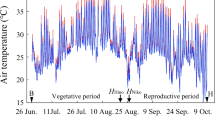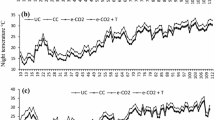Abstract
The present field experiment was conducted during two consecutive cropping seasons in central Portugal to study the effects of simultaneous elevation of carbon dioxide concentration ([CO2]) (550 μmol mol−1) and air temperature (+2–3 °C) on japonica rice (Oryza sativa L. “Ariete”) yield, crop duration, and SPAD-values across the seasons compared with the open-field condition. Open-top chambers were used in the field to assess the effect of elevated air temperature alone or the combined effect of elevated air temperature and atmospheric [CO2]. Open-field condition was assessed with randomized plots under ambient air temperature and actual atmospheric [CO2] (average 382 μmol mol−1). Results obtained showed that the rice “Ariete” had a moderate high yielding under open-field condition, but was susceptible to air temperature rise of +2–3 °C under controlled conditions resulting in reduction of grain yield. The combined increase of atmospheric [CO2] with elevated air temperature compensated for the negative effect of temperature rise alone and crop yield was higher than in the open-field. SPAD-readings at reproductive stage explained by more than 60 % variation the straw dry matter, but this finding requires further studies for consolidation. It can be concluded that potential increase in air temperature may limit rice yield in the near future under Mediterranean areas where climate change scenario poses a serious threat, but long term field experiments are required.





Similar content being viewed by others
References
Ainsworth EA (2008) Rice production in a changing climate: a meta-analysis of responses to elevated carbon dioxide and elevated ozone concentrations. Global Change Biol 14:1642–1650
Akita S (1989) Improving yield potential in tropical rice, in Progress in Irrigated Rice Research. Proc Intl Rice Res Conf, Hanzon, China, 21–25 September 1987
Balasubramanian V, Morales AC, Cruz RT, Abdulrachman S (1999) On-farm adaptation of knowledge-intensive nitrogen management technologies for rice systems. Nutr Cycl Agroecosyst 53:93–101
Bhattacharyya P, Roy KS, Neogi S, Dash PK, Nayak AK, Mohanty S, Baig MJ, Sarkar RK, Rao KS (2013) Impact of elevated CO2 and temperature on soil C and N dynamics in relation to CH4 and N2O emissions from tropical flooded rice (Oryza sativa L.). Sci Total Environ 461–462:601–611
Biswas PK, Ntanos D (2002) Geographical diversity and its influence on rice yield. Kasetsart J (Nat Sci) 36:345–352
Cheng W, Sakai H, Yagi K, Hasegawa T (2009) Interactions of elevated CO2 and night temperature on rice growth and yield. Agr For Meteorol 149:51–58
Confalonieri R, Bocchi S (2005) Evaluation of CropSyst for simulating the yield of flooded rice in northern Italy. Europ J Agron 23:315–326
De Costa WAJM, Weerakoon WMW, Herath HMLK, Abeywardena RMI (2003) Response of growth and yield of rice (Oryza sativa) to elevated atmospheric carbon dioxide in the sub-humid zone of Sri Lanka. J Agron Crop Sci 189:83–95
De Raïssac M, Andebert A, Roques S, Bolomier J (2004) Competition between plants affects phenology in rice cultivars. 12th Australian Agronomy Conference, 4th ICSC: Australian Society of Agronomy
Dobermann A, Fairhurst T (2000) Rice: Nutrient Disorders & Nutrient Management. Potash & Phosphate Institute (PPI), Potash & Phosphate Institute of Canada (PPIC) and International Rice Research Institute (IRRI), pp 201
Esfahani M, Abbasi HRA, Rabiei B, Kavousi M (2008) Improvement of nitrogen management in rice paddy fields using chlorophyll meter (SPAD). Paddy Water Environ 6:181–188
Figueiredo N, Menino R, Prazeres A, Fareleira P, Vargues A, Carranca C, Marques P, Pereira J, Goufo P, Trindade H, Carneiro J, Couto N, Mateus E, Ribeiro A, Coutinho J (2013) O cultivo do arroz em Portugal e a resposta do agrossistema às alterações ambientais de temperatura e concentração de dióxido de carbono. Vida Rural 1787:28–31
Gholizadeh A, Amin MSM, Anuar AR, Aimrun W (2009) Evaluation of SPAD chlorophyll meter in two different rice growth stages and its temporal variability. Eur J Scient Res 37:591–598
Goufo P, Ferreira LMM, Carranca C, Rosa EAS, Trindade H (2014a) Effect of elevated carbon dioxide (CO2) on rice quality: proximate composition, dietary fibres and free sugars. Cereal Chem. doi:10.1094/CCHEM-09-13-0180-R
Goufo P, Pereira J, Figueiredo N, Oliveira MBPP, Carranca C, Rosa EAS, Trindade H (2014b) Effect of elevated carbon dioxide (CO2) on phenolic acids, flavonoids, tocopherols, tocotrienols, γ-oryzanol and antioxidant capacities of rice (Oryza sativa L.). J Cereal Sci 59:15–24
Goufo P, Pereira J, Moutinho-Pereira J, Correia CM, Figueiredo N, Carranca C, Rosa EAS, Trindade H (2014c) Rice (Oryza sativa L.) phenolic compounds under elevated carbon dioxide (CO2) concentration. Environ Exp Bot 99:28–37
Goufo P, Falco V, Brites C, Wessel DF, Kratz S, Rosa EAS, Carranca C, Trindade H (2014d) Effect of elevated CO2 on rice quality: nutritive value, appearance, milling and cooking properties. Cereal Chem. doi:10.1094/CCHEM-12-13-30256-R
IUSS Working Group (2006) World Reference Base for Soil Resources 2006, Volume 103, World Soil Resources Report, 2ª Edição, Roma, FAO
Haque MM, Hamid A, Khanam M, Biswas DK, Karim MA, Khaliq QA, Hossain MA, Uprety DC (2006) The effect of elevated CO2 concentration on leaf chlorophyll and nitrogen contents in rice during post-flowering phases. Biol Plant 50:69–73
IPCC (2007) Summary for policy makers. In: The physical science basis. Solomon S D, Qin M, Manning Z, Chen M, Marquis M, Avery KB, Tignor M, Miller H L (Eds). Contribution of Working Group I to the Fourth Assessment Report of the Intergovernmental Panel on Climate Change, UK: Climate Change 2007: Cambridge University Press
IRRI (Int. Rice Res. Inst.) (1997) Rice almanac, 2nd edn. IRRI, Manila, p 184
Krishnan P, Ramakrishnan B, Reddy KR, Reddy VR (2011) High temperature effects on rice growth, yield, and grain quality. Adv Agron 111:87–206
Liu Q-H, Wu X, Li T, Ma J-Q, Zhou X-B (2013) Effects of elevated air temperature on physiological haracteristics of flag leaves and grain yield in rice. Chil J Agrc Res 73:85–90
Madan P, Jagadish SVK, Craufurd PQ, Fitzgerald M, Lafarge T, Wheeler TR (2012) Effect of elevated CO2 and high temperature on seed-set and grain quality of rice. J Exp Bot 63:3843–3852
Matsui T, Namuco OS, Ziska LH, Horie T (1997) Effect of high temperature and CO2 concentration on spikelet sterility in indica rice. Field Crops Res 51:213–219
Mohammed AR, Tarpley L (2009) High nighttime temperatures affect rice productivity through altered pollen germination and spikelet fertility. Agric For Meteorol 149:999–1008
Neto C, Carranca C, Clemente J, de Varennes A (2011) Assessing the N nutritional status of young non-bearing ‘Rocha’ pear trees grown in a Mediterranean region using a chlorophyll meter. J Plant Nutr 34:627–639
Oh-e I, Saitoh K, Kuroda T (2007) Effects of high temperature on growth, yield and dry matter production of rice grown in the paddy field. Plant Prod Sci 10:412–422
Pereira J, Figueiredo N, Goufo P, Carneiro J, Morais R, Carranca C, Coutinho J, Trindade H (2013) Effects of elevated temperature and atmospheric carbon dioxide concentration on the emissions of methane and nitrous oxide from Portuguese flooded rice fields. Atmos Environ 80:464–471
Piekielek W, Linenfelter D, Beegle D, Fox R (2008) The early season chlorophyll meter for corn. Agron Facts 53:1–8
Satapathy SS, Swain DK, Herath S (2014) Field experiments and simulation to evaluate rice cultivar adaptation to elevated carbon dioxide and temperature in sub-tropical India. Eur J Agron 54:21–33
Shoor M, Mondani F, Aliverdi A, Golzardi F (2012) Interaction effect of CO2 enrichment and nutritional conditions on physiological characteristics, essential oil and yield of lemon Balm (Melissa officinalis L.). Not Sci Biol 4:121–130
Sreenivasan PS (1985) Agro-climatology of rice in India. Rice research in India. ICAR, New Dehli, pp 213–214
Swain DK, Sandip SJ (2010) Development of SPAD values of medium-and long duration rice variety for site-specific nitrogen management. J Agron 9:38–44
Tran DV (1997) World rice production main issues and technical possibilities. Cah Opt Mediterr 24:57–69
Wang Y, Frei M, Song Q, Yang L (2011) The impact of atmospheric CO2 concentration enrichment on rice quality–a research review. Acta Ecol Sin 31:277–282
Wassmann R, Jagadish SVK, Heuer S, Ismail A, Redona E, Serraj R, Singh RK, Howell G, Pathak H, Sumfleth K (2009) Climate change affecting rice production: the physiological and agronomic basis for possible adaptation strategies. Adv Agron 101:59–122
Weerakoon WMW, Ingram KT, Moss DN (2005) Atmospheric CO2 concentration effects on N partitioning and fertilizer N recovery in field grown rice (Oryza sativa L.). Agric Ecosyst Env 108:342–349
Acknowledgement
Authors acknowledge COTArroz and its staff for facilities, climatic data, and help for the field work, as well as the reviewers for their constructive suggestions. Authors also acknowledge the Portuguese Foundation for Science and Technology (FCT, Portugal) for the financial support through the project PTDC/AGR-AAM/102529/2008. This work was also supported by European Union Funds (FEDER/COMPETE-Operational Competitiveness Programme) and by national funds (FCT) under the project FCOMP-01-0124-FEDER-022692.
Author information
Authors and Affiliations
Corresponding author
Rights and permissions
About this article
Cite this article
Figueiredo, N., Carranca, C., Trindade, H. et al. Elevated carbon dioxide and temperature effects on rice yield, leaf greenness, and phenological stages duration. Paddy Water Environ 13, 313–324 (2015). https://doi.org/10.1007/s10333-014-0447-x
Received:
Revised:
Accepted:
Published:
Issue Date:
DOI: https://doi.org/10.1007/s10333-014-0447-x




